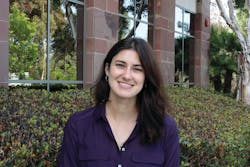Top 40 Under 40 2013: Marie Lewis Adams
In just six years at Transportation Management & Design Inc., Marie Lewis Adams has rapidly advanced to a point where she is now leading TMD’s transit planning practice, one that focuses on helping transit systems reinvent themselves sustainably. She has led or is leading reinvention projects across the country including San Francisco Inner East Bay (BART/AC Transit), Santa Monica (Big Blue Bus), Pinellas County (PSTA), San Mateo County (SamTrans), Sacramento (RT), Broward County (BCT), and San Joaquin County (RTD) and helped manage the landmark Transit Effectiveness Project (TEP) for San Francisco MTA (Muni). She is involved in every aspect of the planning process, including consumer research, market demand and service analysis, service restructuring, mobility framework development, stakeholder outreach and implementation.
Lewis Adams develops sustainable transit system solutions, with particular emphasis on enhancing service quality and cost-effectiveness, which have application for all systems across the country. The recent Sacramento Transit Renewal Plan involved rebuilding RT service to pre-economic downturn levels in a more sustainable fashion, focusing on core market areas while reshaping the network to support new rail initiatives.
The Broward County Transit Comprehensive Operational Analysis provided an opportunity to coordinate with multiple regional agencies and develop a network of enhanced bus corridors. The San Joaquin RTD Comprehensive Operational Analysis was a joint effort between RTD and the city of Stockton to produce a plan to improve transit service while also addressing relevant land-use issues and greenhouse gas emissions (California SB375). She is also leading another sustainability study with broad industry application — this one for the Foothill Boulevard corridor in San Bernardino County that is simultaneously laying out BRT and new land-use development strategies for the corridor communities. She has presented many of these industry best practice findings at APTA conferences.
Lewis Adams continues to lead TMD’s work for the San Francisco Bay MTC Transit Sustainability Project, a region-wide effort to develop service warrants, performance standards, and best practices to assist Bay Area transit systems in improving both effectiveness and efficiency. She is leading TMD’s work as the GPC for Denver RTD; her project accomplishments include a second downtown free BRT shuttle, statistically based service warrants and performance standards, timed transfer network optimization, and community-based transit initiatives linked to the new Denver Union Station.
Lewis Adams came to TMD with outstanding academic credentials with a Masters of city and regional planning from the University of Pennsylvania and Bachelors in geography from UCLA. She interned with both Kittelson and Associates and Shapouri and Associates before settling on transit planning at TMD.
"I love to talk with different systems about when and how transit works, when and how it doesn’t work, and how to move transit in a more productive, sustainable direction. It’s wonderful to see people start to understand how the pieces come together to create a really great system.
"A lot of it comes down to putting oneself in the shoes of potential transit customers to understand how people make travel decisions (how long does it take me to get to where I need to go? How convenient is my trip?). Once people start thinking about how they personally would use transit, it’s not a far leap to recognize that those same principles can be applied to an entire transit network — fast, frequent, direct, reliable service supported by transit-friendly land uses and urban design.
"I would like for transit agencies and decision-makers to capitalize on the importance of frequency for ridership generation and overall network effectiveness. In a limited-resource environment, many systems prefer operating low-frequency service on a larger number of routes over concentrating resources and frequency on strong routes. However, the amount of customers who will plan their trip on low-frequency service by consulting printed schedules is relatively small — there is a much larger market of customers who would ride if they could simply walk out to the street and catch a bus or train quickly. It’s easier and more convenient for the customer and provides a big payback for the agency –higher ridership and farebox recovery."
